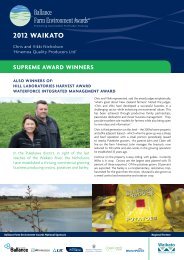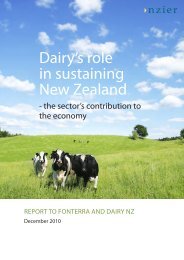NZIER report on compensation for transmission infrastructure
NZIER report on compensation for transmission infrastructure
NZIER report on compensation for transmission infrastructure
You also want an ePaper? Increase the reach of your titles
YUMPU automatically turns print PDFs into web optimized ePapers that Google loves.
there will be an incentive <strong>for</strong> Transpower to use them in situati<strong>on</strong>s where other<br />
opti<strong>on</strong>s involve less real resource cost. This would lower l<strong>on</strong>g term net welfare.<br />
From a transmissi<strong>on</strong> utility‟s perspective easements are worthwhile if they are less<br />
costly than alternative opti<strong>on</strong>s <strong>for</strong> routeing and locating transmissi<strong>on</strong> lines and<br />
facilities. The saving relative to the next best alternative creates an ec<strong>on</strong>omic surplus<br />
<strong>for</strong> the utility. From a nati<strong>on</strong>al perspective, however, the true surplus is over and<br />
above the full cost of the easement, including the compensati<strong>on</strong> paid <strong>for</strong> it.<br />
2.2 Equity – splitting the surplus<br />
Equity is c<strong>on</strong>cerned with how efficiency gains or rents from ec<strong>on</strong>omic activity are<br />
distributed between parties. Bey<strong>on</strong>d covering the full cost of land occupancy,<br />
easements also create some ec<strong>on</strong>omic rent in savings relative to the next best<br />
alternative. In New Zealand the total surplus appears to accrue to Transpower, as it<br />
is legally required to provide compensati<strong>on</strong> equal <strong>on</strong>ly to what the easements cost<br />
landowners. In other countries, however, landowners share in the surplus created by<br />
easements. 10<br />
Other than identifying the distributi<strong>on</strong> of costs and benefits (both direct and indirect)<br />
across the parties, ec<strong>on</strong>omics has little to say about equity, percepti<strong>on</strong>s of which are<br />
determined in each community according to factors such as social and political<br />
c<strong>on</strong>siderati<strong>on</strong>s. On the other hand, although splitting a surplus may be c<strong>on</strong>sidered<br />
purely a distributi<strong>on</strong>al issue, there are situati<strong>on</strong>s in which it affects efficiency as well<br />
(see 2.3.2 below).<br />
2.3 An ec<strong>on</strong>omic framework<br />
As discussed above an accurate assessment and comparis<strong>on</strong> of the total costs <strong>for</strong><br />
transmissi<strong>on</strong> <strong>infrastructure</strong> is needed so as to identify the most efficient opti<strong>on</strong> <strong>for</strong><br />
transmitting electricity. The net cost of an easement includes the impact of<br />
transmissi<strong>on</strong> lines <strong>on</strong> the value of the affected land, incorporating any change to<br />
future sales value and the net present value of revenue streams. These costs are<br />
borne by landowners in the first instance and are represented by the upwards sloping<br />
line in Figure 1. (The line slopes up as landowner easement costs vary with landuse).<br />
This line represents, if all costs are known, the minimum price a landowner<br />
would be willing to accept <strong>for</strong> an easement.<br />
10 In Canada, Finland, and the United Kingdom <strong>for</strong> example, see Nuuja and Viitanen 2007; Hydro-<br />
Quebec 2000 and Hamer and O‟Brien 2007.<br />
<str<strong>on</strong>g>NZIER</str<strong>on</strong>g> – Compensati<strong>on</strong> <strong>for</strong> transmissi<strong>on</strong> <strong>infrastructure</strong> 11
















